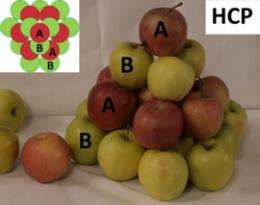What is the best way of stacking apples?

When stacking apples on a market stall, fruit sellers "naturally" adopt a particular arrangement: a regular pyramid with a triangular base. A French-German team, which includes in particular the Laboratoire de Physique des Solides, has demonstrated that this arrangement is favored for reasons of mechanical stability. This work, which is published on the Physical Review Letters (PRL) website, could contribute to the design of organized porous materials.
Take apples or marbles. The best way to stack them consists in erecting a pyramid layer by layer, which ensures the maximum number of spheres is fitted into the minimum amount of space. There are several arrangements for stacking such identical spheres (of the same volume) with the same, optimal density. Two, in particular, are well known: a structure known as face centered cubic (FCC), whose base is necessarily a triangle for the smallest possible pyramid, and a hexagonally close-packed (HCP) structure with a hexagonal base, also when constructing the smallest possible pyramid. The first arrangement consists of a periodic repetition of three different positions of layers: ABCABC…. In the second, two different positions of layers are periodically repeated: ABABAB.... As early as 1611, while studying the stacking of canon balls, the scientist Johannes Kepler proposed the FCC arrangement as being the most efficient. It is moreover the arrangement used by stall holders to stack their fruit and vegetables.
In addition, the FCC structure turns out to last longer than the HCP arrangement, particularly during the spontaneous formation of stacks of bubbles, drops or solid grains of equal volume. Why is there such a preference when both structures result in the same compactness? That is the question the researchers set themselves to solve. One of the explanations put forward so far is a higher disorder (or entropy) in FCC stacking than in an HCP arrangement. But this argument, which could be true for very small objects of nano- or microscopic size, no longer holds for macroscopic objects such as bubbles or drops.

The researchers carried out numerical simulations and experiments with macroscopic spheres of different sizes (greater than 10-6 meters). After throwing the spheres into a box, they observed how they formed into stacks and then subjected the system to mechanical tests. The researchers demonstrated that the two arrangements, FCC and HCP, formed with the same probability. However, the hexagonally close-packed structure is more frequently destroyed when new spheres are added and it is then converted into a more stable face centered cubic structure. In this way, they demonstrated that the FCC arrangement is mechanically more stable than any other compact hexagonal structure. Why is that? At the surface of a pyramidal stacking, several neighboring spheres are missing. In FCC structures, since the forces are transferred via straight lines, this does not cause an imbalance of the system. However, in other stacking arrangements, a resulting force is exerted towards the exterior on the spheres situated at the edges, which pushes them away from the stack.
If this force is not compensated by a sufficient force of gravity or friction, the HCP structure collapses. Thus, a pyramid comprising four layers of spheres without friction in an HCP arrangement can collapse under its own weight. Conversely, layers can be stacked indefinitely in a FCC structure. External phenomena, such as hustle and bustle or constant passing-by near the edifice, can destabilize the structure and thereby induce the formation of the FCC arrangement. The scientists are now attempting to determine whether this mechanism is involved in other situations: shearing of the edifice, use of “soft” spheres, etc. It could play a significant role in certain porous materials organized into regular arrays.
More information: Packing spheres tightly: Influence of mechanical stability on close-packed sphere structures, S. Heitkam, W. Drenckhan and J. Fröhlich. Phys. Rev. Lett. 108, 148302 (2012). Published on line on the 5 April 2012.
Journal information: Physical Review Letters
Provided by CNRS



















